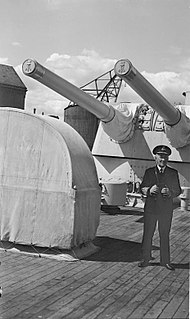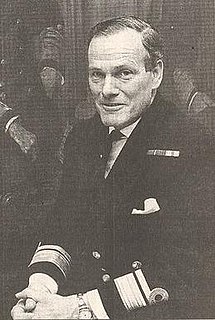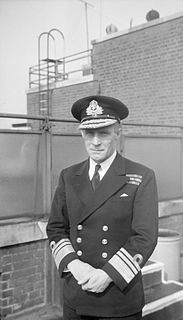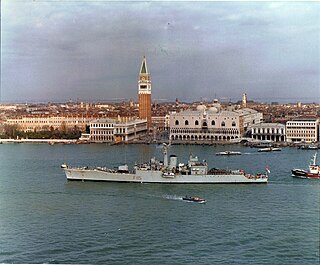
The Second Sea Lord (2SL) is one of the most senior admirals of the British Royal Navy, responsible for personnel and naval shore establishments. Originally titled Second Naval Lord in 1830, the post was restyled Second Sea Lord in 1904. He is based at Navy Command, Headquarters.
Admiral of the Fleet Sir David Benjamin Bathurst is a former Royal Navy officer. After training as a pilot and qualifying as a helicopter instructor, Bathurst commanded a Naval Air Squadron and then two frigates before achieving higher command in the Navy. He served as First Sea Lord and Chief of the Naval Staff from 1993 to 1995: in that capacity he advised the British Government on the deployment of Naval Support including Sea Harriers during the Bosnian War.
Admiral Sir Frederic Charles Dreyer, was an officer of the Royal Navy. A gunnery expert, he developed a fire control system for British warships, and served as Jellicoe's flag captain at Jutland. He retired with the rank of admiral in 1943, having served through two world wars and having already retired once.

Rear Admiral Neil Morisetti, is a retired Royal Navy officer who is an Honorary Professor and Director of Strategy at University College London's Science, Technology, Engineering and Public Policy Department.

Admiral of the Fleet Sir Rhoderick Robert McGrigor GCB was a senior Royal Navy officer. He fought in the First World War and saw action during the Gallipoli Campaign and then the Battle of Jutland. He also served in the Second World War, taking part in the sinking of the Bismarck in May 1941, carrying out the office of Assistant Chief of the Naval Staff (Weapons) and commanding the 1st Cruiser Squadron during operations off the Norwegian coast and convoys to North Russia. He served as First Sea Lord in the early 1950s and is most remembered as a leading proponent of carrier-based air power.

Admiral Sir John David Luce & Bar, was a Royal Navy officer. He fought in the Second World War as a submarine commander before taking part in the Dieppe Raid and becoming Chief Staff Officer to the Naval Forces for the Normandy landings. He also commanded a cruiser during the Korean War. He served as First Sea Lord and Chief of the Naval Staff in the mid-1960s and in that role resigned from the Royal Navy along with Navy Minister Christopher Mayhew in March 1966 in protest over the decision by the Labour Secretary of State for Defence, Denis Healey, to cancel the CVA-01 aircraft carrier programme.

Admiral of the Fleet Sir William Doveton Minet Staveley was a Royal Navy officer. Staveley saw service as a minesweeper commander on coastal patrol during the Indonesia–Malaysia confrontation before commanding a frigate and then an aircraft carrier and ultimately achieving higher command in the Navy. He served as First Sea Lord and Chief of Naval Staff in the late 1980s. In that role he fought hard for a fleet large enough to meet NATO commitments.
Vice Admiral Sir Arthur Lumley St George Lyster was a Royal Navy officer during the Second World War.
Admiral Sir Brian Thomas Brown KCB CBE is a senior Royal Navy officer who went on to be Second Sea Lord and Chief of Naval Personnel.

Admiral Sir Guy Charles Cecil Royle was a Royal Navy officer who went on to be Fifth Sea Lord and First Naval Member of the Royal Australian Navy.
Vice Admiral Sir Richard Jeffrey Ibbotson, is a former Royal Navy officer who served as Deputy Commander-in-Chief Fleet.

Admiral Sir Angus Edward Malise Bontine Cunninghame Graham of Gartmore and Ardoch KBE CB was a Royal Navy officer who became Flag Officer, Scotland.

Rear Admiral James Anthony Morse CB is a senior Royal Navy officer who served as Assistant Chief of Naval Staff (Capability) and Controller of the Navy.
Admiral Sir (Arthur) Robin (Moore) Bridge KBE CB (1894–1971) was a senior Royal Navy officer who commanded the Reserve Fleet.
Rear Admiral Roger Charles Lane-Nott, is a former Royal Navy officer who served as Commander Operations and Flag Officer Submarines.

Rear Admiral Arthur David Torlesse was a Royal Navy officer. He commanded the escort carrier HMS Hunter during the latter part of the Second World War, and the aircraft carrier HMS Triumph during the early months of the Korean War. In 1952, he commanded the task force that supported Operation Hurricane, the first British nuclear weapons test.

The Assistant Chief of the Naval Staff is a senior Royal Navy appointment responsible for naval aviation. The post is also the successor to the Royal Navy's Flag Officer for naval aviation in the British Isles, established since 1939.
Rear Admiral John Oliver Roberts CB is a former Royal Navy officer who served as Flag Officer, Naval Air Command.













